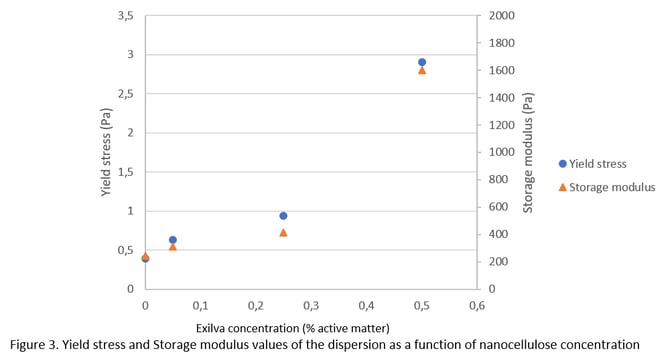
How yield stress play an important role in anti-settling in your paint
Katérina Liapis | October 29, 2019
Undesirable phenomena such as sedimentation and settling can often occur during the storage of paints. Therefore, a re-dispersion step is necessary which can mean additional cost. These challenges can be even more pronounced in high solid content formulations and so it is crucial to secure stability of those systems. To avoid these effects, rheology modifiers need to be added to paint formulations. So, I prepared some information for you and conducted a couple of tests with the rheology additive nanocellulose to show you how focus on yield stress will reduce sedimentation and settling.
How yield stress and sedimentation/settling work
In the previous blog post on yield stress and sedimentation & settling, we explained what sedimentation is and how we can predict it. We also introduced the concept of storage modulus and yield stress, two rheological parameters that can be used to predict stability. As a reminder, the yield stress is the threshold amount of shear stress that can be applied to the system before the network starts to break down. The storage modulus is a quantification of the strength of the physical network that is present within the system: a high G’ value indicates that the physical network is strong.
So, here´s the deal: we want to show you the basic properties of the nanocellulose technology in a titanium dioxide dispersion. We then compare this to a reference dispersion (no rheology modifier) to show you how Exilva can be your little helper in avoiding sedimentation and settling by building yield stress.
The test
Laboratory tests on dispersions of 60% Kronos 2310 (a water-based white titanium dioxide pigment) with an active content of 0.05%, 0.25% and 0.5% Exilva nanocellulose were tested. These samples were compared to a reference dispersion without the presence of a rheology modifier. The visual stability, as well as the rheological properties of these dispersions were studied.
Settling tests have been performed on the pigment dispersions 24h, 7 days and 28 days after preparation. This was done both on the reference dispersion (without Exilva MFC, Figure 1) and on the dispersion with 0.5% Exilva (Figure 2).
The results
After 24h, the reference sample shows already signs of degradation illustrated by the large separation of the pigment on the spatula surface while Exilva nanocellulose dispersion is stable. Over time, both the reference and the dispersion with Exilva show deterioration, with a lower degree of instability for the dispersion with Exilva, implying improved anti-settling properties. In addition, 24h and 7 days after preparation, the dispersion with Exilva shows a remarkably lower degree of syneresis than the reference sample. The addition of Exilva into the pigments dispersions provides excellent anti-sedimentation/anti-settling and anti-syneresis properties.


The rheological measurements agree with the visual tests.
Figure 3 shows the yield stress and the storage modulus of the samples as a function of Exilva concentration. The storage modulus and yield stress are increasing with Exilva concentration. The higher the concentration of nanocellulose in the formulation, the more interactions can be built between the pigments and the nanocellulose resulting in a stronger network and therefore, a better ability to maintain pigments in suspension

Thanks to its 3D-network, nanocellulose can provide strength to the formulation. The elastic behavior of the fibrils, illustrated by high yield stress and storage modulus values, enables the network to maintain the pigment in suspension. This results in excellent stabilizing properties and can therefore allow improvement in reducing settling and syneresis effects, especially in high load pigment dispersions.
Written by:
Katérina Liapis
Katerina joined Borregaard in 2017 as a research scientist and focused on the Exilva product and its performance in adhesives. She is now working as a Technical Application Manager. Katerina has a master degree in polymer material science from the University of Strasbourg, France and experience from international companies.
